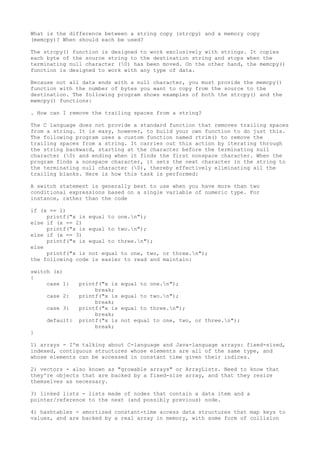I1
- 1. What is the difference between a string copy (strcpy) and a memory copy (memcpy)? When should each be used? The strcpy() function is designed to work exclusively with strings. It copies each byte of the source string to the destination string and stops when the terminating null character (0) has been moved. On the other hand, the memcpy() function is designed to work with any type of data. Because not all data ends with a null character, you must provide the memcpy() function with the number of bytes you want to copy from the source to the destination. The following program shows examples of both the strcpy() and the memcpy() functions: . How can I remove the trailing spaces from a string? The C language does not provide a standard function that removes trailing spaces from a string. It is easy, however, to build your own function to do just this. The following program uses a custom function named rtrim() to remove the trailing spaces from a string. It carries out this action by iterating through the string backward, starting at the character before the terminating null character (0) and ending when it finds the first nonspace character. When the program finds a nonspace character, it sets the next character in the string to the terminating null character (0), thereby effectively eliminating all the trailing blanks. Here is how this task is performed: A switch statement is generally best to use when you have more than two conditional expressions based on a single variable of numeric type. For instance, rather than the code if (x == 1) printf("x is equal to one.n"); else if (x == 2) printf("x is equal to two.n"); else if (x == 3) printf("x is equal to three.n"); else printf("x is not equal to one, two, or three.n"); the following code is easier to read and maintain: switch (x) { case 1: printf("x is equal to one.n"); break; case 2: printf("x is equal to two.n"); break; case 3: printf("x is equal to three.n"); break; default: printf("x is not equal to one, two, or three.n"); break; } 1) arrays - I'm talking about C-language and Java-language arrays: fixed-sized, indexed, contiguous structures whose elements are all of the same type, and whose elements can be accessed in constant time given their indices. 2) vectors - also known as "growable arrays" or ArrayLists. Need to know that they're objects that are backed by a fixed-size array, and that they resize themselves as necessary. 3) linked lists - lists made of nodes that contain a data item and a pointer/reference to the next (and possibly previous) node. 4) hashtables - amortized constant-time access data structures that map keys to values, and are backed by a real array in memory, with some form of collision
- 2. handling for values that hash to the same location. 5) trees - data structures that consist of nodes with optional data elements and one or more child pointers/references, and possibly parent pointers, representing a heirarchical or ordered set of data elements. 6) graphs - data structures that represent arbitrary relationships between members of any data set, represented as networks of nodes and edges. 1) What are some really common data structures, e.g. in java.util? 4) How do you print out the nodes of a tree in level-order (i.e. first level, then 2nd level, then 3rd level, etc.) Describe a function that takes an int value, and returns true if the bit pattern of that int value is the same if you reverse it (i.e. it's a palindrome); i.e. boolean isPalindrome(int x) Bad Sign #2: Me: So! What data structures do we have available to us, as programmers? Them: Arrays, queues, vectors, stacks, lists, um, linked lists... Me: OK, any others? Them: Um, doubly-linked lists, and, uh, array lists. Me: Have you ever used a tree? Them: Oh! (laughs) Yeah, um, I forgot about those. Me: So! What text-editor do you use? Them: Visual Studio. Me: OK. What about on Unix? Them: On Unix I use vi. Me: Er, yeah, vi is cool... ever used VIM? Them: No, just vi. Always worked just fine for me. http://cplus-interview-questions.blogspot.in/


